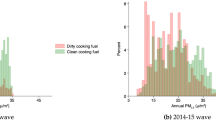Abstract
Forest burning stands as a highly used practice in the Brazilian Amazon Forest. Burning trees is the cheapest way to expand agricultural frontiers in the Amazon region. Nevertheless, the smoke generated in this process can produce undesirable negative effects, in particular health-induced problems by the polluted air. This study aims to investigate whether these effects on the health of the region’s population are statistically significant, using as variables mortality and morbidity rates associated with respiratory diseases. The estimated morbidity model was used to estimate the health damage to those people who became ill only by the fire.
Similar content being viewed by others
Notes
A contingent valuation technique may be adopted by asking people directly about their willingness to pay or accept variation in the risk to life or the incidence of an ailment. Or more commonly, by observing the wage variation regarding the variation of risk in the occupation.
We would like to thank the referee for this suggestion.
Following the referee’s suggestion, we also estimate the same models that appear in Table 1 using the morbidity caused by waterborne diseases (Cholera, intestinal infections, typhoid fever, Poliomyelitis, Shigellosis, Shistosomosis, and Amoebic dysentery) as a dependent variable. In all regressions, the independent variable, fogo, does not contribute to increase morbidity. Following the referee’s rationality, we can infer that our results are not spurious. The results of these estimations are available upon request.
Under certain conditions, the central limit theorem guarantees that the estimate distribution converges towards normal. In the case of this distribution, the mean value coincides with the most probable value, which is the mode.
References
Ardila S, Queiroga R, Vaugham WJ (1998) A review of the use of contingent valuation methods in project analysis at the Inter-American Developing Bank. Report of Vanderbilt University, Nashville
Breusch TS, Mizon GE, Schmidt P (1986) Efficient estimation using panel data. Econometrica 57(3):695–700
Cornwell C, Rupert P (1988) Efficient estimation with panel data: an empirical comparison of instrumental variables. J Appl Econ 3:149–155
Externe E (1998) Externalities of fuel cycles: economic valuations—an impact valuations approach. http://externe.jrc.es/publications
Hausman J (1978) A specification test in econometrics. Econometrica 46(6):1251–1271
Hausman JA, Taylor W (1981) Panel data and unobservable individual effects. Econometrica 49(6):1377–1398
Heintz RJ, Tol RSJ (1996) Secondary benefits of climate control policies implications for the global environment facility. CSERGE Working paper GEC 96-17, London
Homma AK (1993) A Dinâmica dos Desmatamentos e das Queimadas na Amazônia: Uma Análise Microeconômica. Anais do XXXI Congresso Brasileiro de Economia e Sociologia Rural 1:663–676
IBGE Instituto Brasileiro de Geografia e Estatística (1987) Diagnóstico Ambiental da Amazônia Legal
Judge G, Hill C, Griffiths W, Lee T, Lütkepohl H (1982) Introduction to the theory and practice of econometrics. Wiley, New York
Johnston J, Dinardo J (1997) Econometric methods. McGraw-Hill International Editions
Markandya A (1998) The valuation of health impacts in developing countries. Planejamento e Políticas Públicas 18:119–143
Nepstad D (1999) Large-scale impoverishment of Amazonian forests by logging and fire. Nature 398:505–508
Nepstad DC, Moreira AG, Alencar AA (1999) A Floresta em Chamas: Origens, Impactos e Prevenção de Fogo na Amazônia. Brasília: programa Piloto para a Proteção das Florestas Tropicais do Brasil
Ostro DB (1987) Air pollution and morbidity revisited: a specification test. J Environ Econ Manage 14:87–98
Ostro DB (1983) The effects of IR pollution on work loss and morbidity. J Environ Econ Manage 10(2):371–382
Pearce D (1998) Valuing statistical lives. Planejamento e Políticas Públicas 18:69–118
Seroa da Motta R, Mendes APF (1995) Custos de Saúde Associados à Poluição do Ar no Brasil. Pesquisa e Planejamento Econômico 25(1):165–198
Seroa da Motta R, Ortiz RA, Ferreira SF (2000) Health and economic values for mortality cases associated with air pollution in Brazil. Expert workshop on assessing the ancillary benefits and costs of greenhouse gas mitigation strategies. Washington, DC, March 27–29
Thomas V (1985) Evaluating pollution control: the case of São Paulo. J Dev Econ 19:133–146
Acknowledgements
We are thankful for helpful comments received from an anonymous referee and the editor for helpful comments on this work. All errors are our own.
Author information
Authors and Affiliations
Corresponding author
Additional information
Responsible editor: Junsen Zhang
Appendix
Appendix
1.1 Appendix 1 Descriptive statistics of the variables of the model
Listed below are the basic statistics for the variables used in the model. As the database was structured as panel data, a slightly more complex presentation was needed for the statistic description of the variables. Had the variables been described in a trivial manner, either by a time series or cross-section, information related to the data sample would be contained in the very first line, where the designation “overall” appears, for which statistics are calculated for the entire data set, and for which differences among groups are not considered. In this case, the moments are described by the means \(\overline{\overline x} \) and \(\overline{\overline y} ,\) in both i and t, for the dependent and independent variables and the total sum of the squares is given by:
As the data structure of the model is presented in panel data form, further analysis is required. The term “within” describes the situation in which the means are broken down by group with regard to the entire sample. Thus, instead of \(\overline{\overline x} \) and \(\overline{\overline y} ,\) we have \(\overline{x} _{i} \) and \(\overline{y} _{i} \) considered only in t for each group i; and the sum of the squares and of the cross products are given by the following expressions:
Lastly, definitions may be made considering the differences among groups. In this case, the term “between” is used. Here, the sum of the squares and the cross products may be expressed as follows:
Table 5 lists the basic statistics of the variables, taking into consideration what was outlined above. Naturally, the blank spaces for the means, with regard to the sample groups “within” and “between,” are there to save space. As there are 261 groups (districts), we would need the same number for these measurements.
1.2 Appendix 2. Database
Regarding the health data, in this study, we have used annual hospital treatment values, average in-patient treatment value, and the average in-patient treatment period related to respiratory illnesses (CID-10 X). The sample covered all districts in the Amazon region. The data also refer to the public health services, extracted from DATASUS, the Ministry of Health’s information service.
The estimation of the area burned used in this study was obtained from the so-called hot pixels. These hot pixels represent satellite-observed fire outbreak points. This information was processed by the Wood Hole Research Center.
With regard to the population data used in this study, a series for this variable had to be constructed. This was due to the fact that there were no annual data available for the districts, as this information is only available for those periods in which the Brazilian Institute of Geography and Statistics (IBGE) census was conducted. The procedure used in this case was to take the district population data for the 1991–1997 period and determine the remaining periods by interpolation based on a linear growth rate, determined by the district population values for the 2 years indicated above.
As information regarding district income was also not available for the period, the real lumber production value (logs), and the real agricultural production value (temporary planting) were tested as proxies for this variable. Another possible proxy for municipal income is the use of a cattle-raising activity index, which is directly related to the growth in the region’s cattle herd. All these data were constructed from information obtained from the Sistema IBGE de Recuperacão Automatica (SIDRA) system of the Agricultural Census, maintained by the IBGE. The municipal income data for all municipalities were only for those years for which a demographic census was conducted.
Data regarding unpaved roads were generated from a joint study conducted by Institute of Applied Economic Research (IPEA) and IBGE (IBGE 1987). Sawed lumber production was obtained from the Institute of Environmental Research for Amazônia (IPAM) database.
Rights and permissions
About this article
Cite this article
Cardoso de Mendonça, M.J., Sachsida, A. & Loureiro, P.R.A. Estimation of damage to human health due to forest burning in the Amazon. J Popul Econ 19, 593–610 (2006). https://doi.org/10.1007/s00148-006-0066-y
Received:
Accepted:
Published:
Issue Date:
DOI: https://doi.org/10.1007/s00148-006-0066-y




